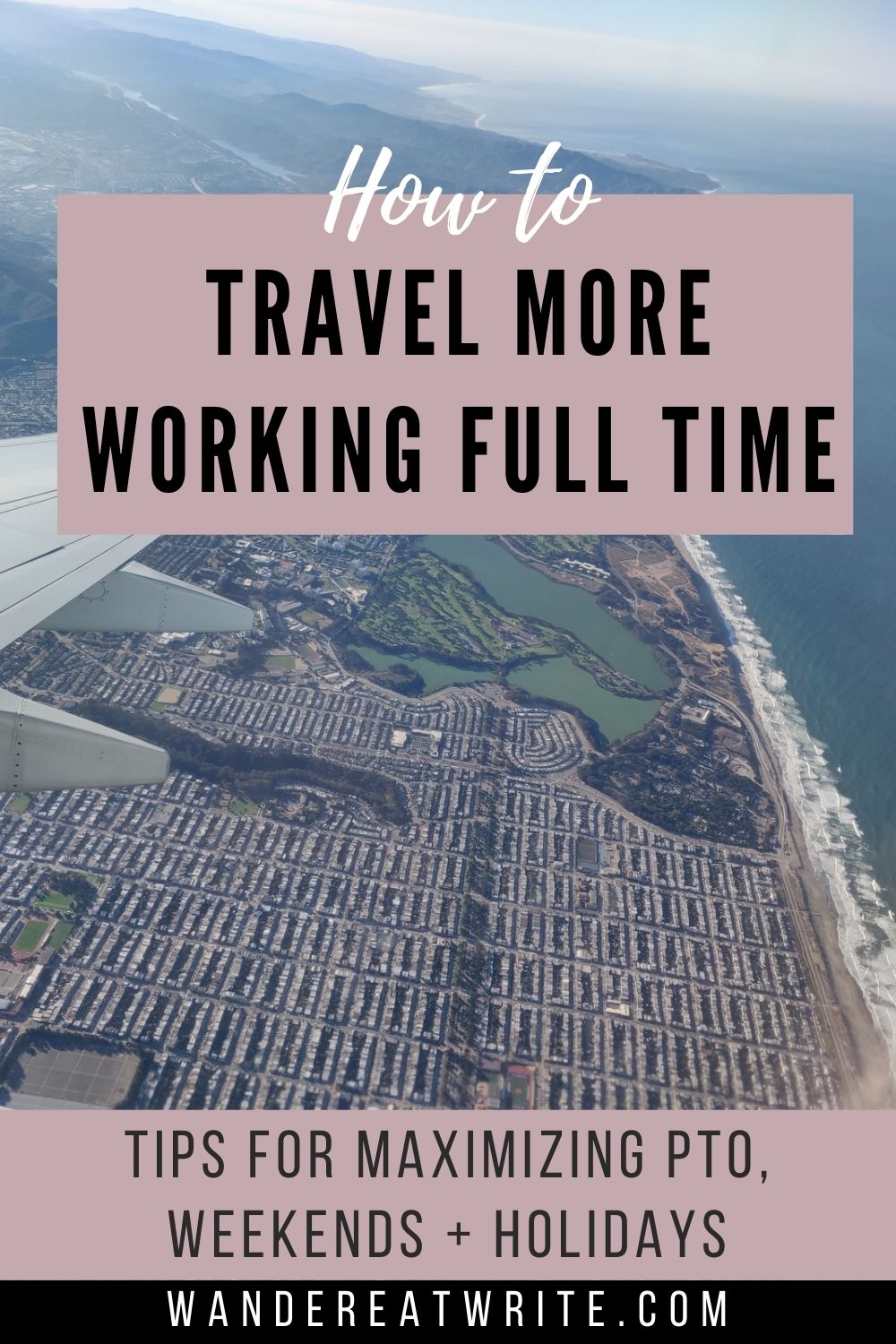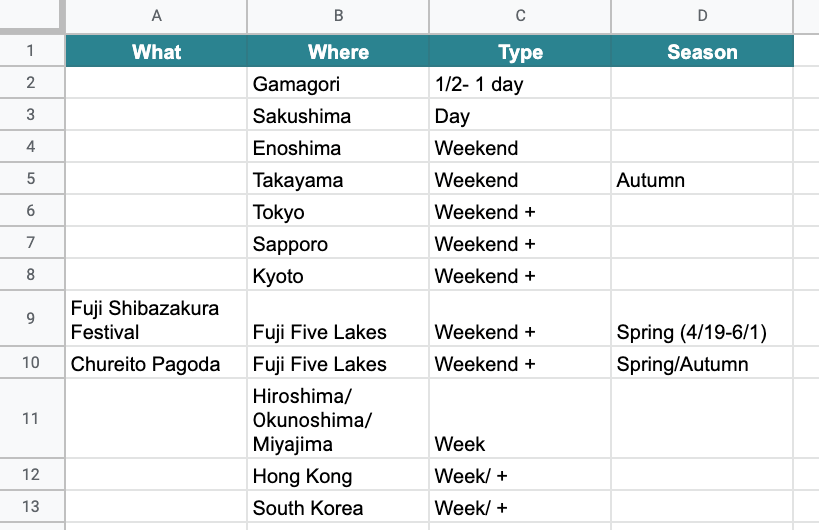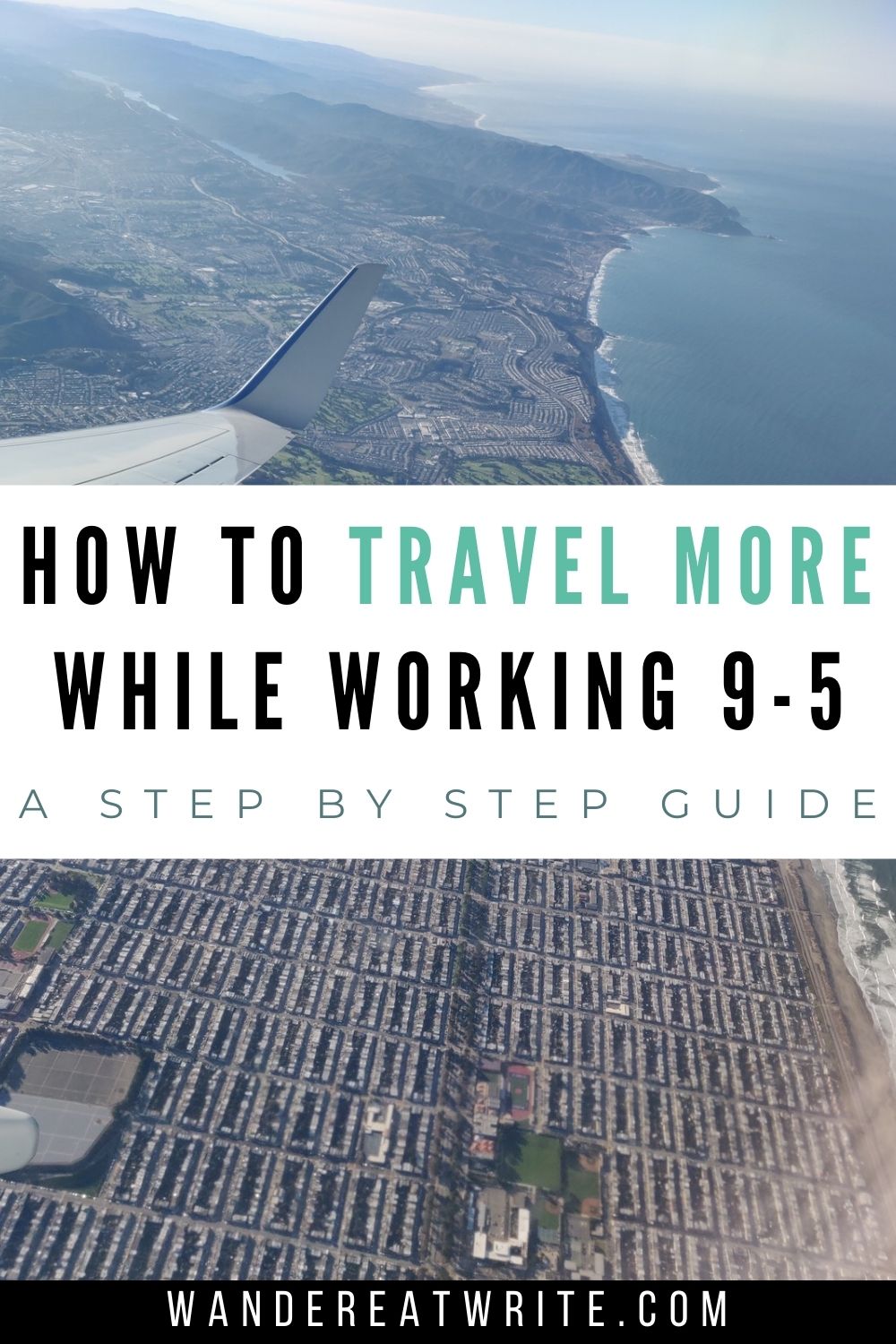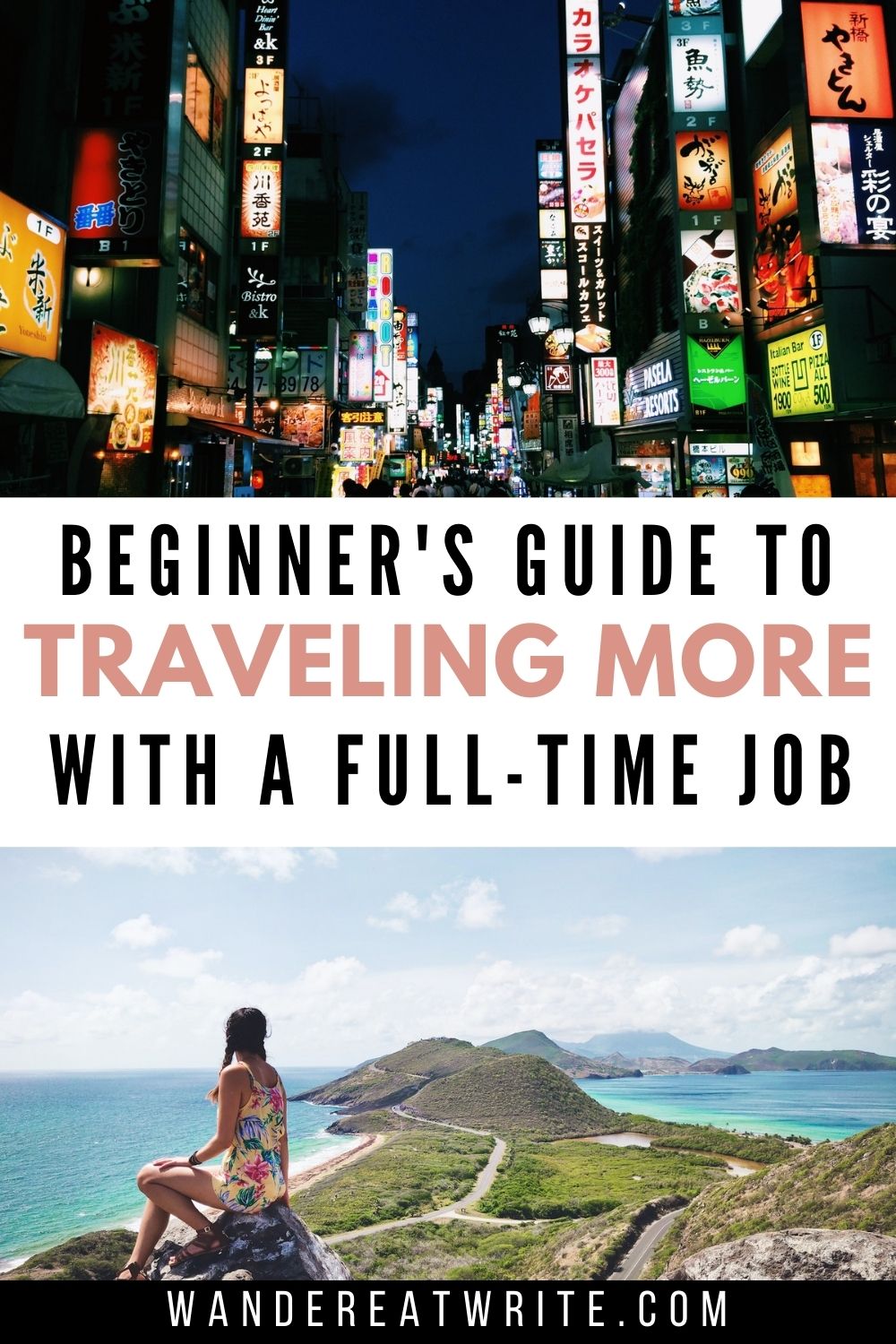What’s the secret to being able to travel more while working full time?
Planning and creativity.
While you might feel constrained with a full-time job, there’s also a silver lining that makes it easier to travel more while working 9-5 in some ways: a predictable schedule.
With set work hours and holidays, all it takes is a good travel plan made for the year and a bit of creativity to get the most mileage (figuratively and literally) out of your work schedule.

As a full-time English teacher in Japan for two years, I was able to visit most of the main Japanese tourist destinations as well as several other neighboring Asian countries and still fit in a trip to Hawaii and a visit back to California to see my family— all by strategically planning out my year according to my work’s holiday schedule.
In this step by step guide, I’ll show you how I was able to travel more while working full time and how you can, too!
Step 1. Define Your Goals
What does “traveling more” mean to you?
Is it going on more local hikes or exploring the immediate area around you? Is it road-trips across the country? Is it international adventures?
Not everyone’s idea of traveling is the same.
Pinpointing what exactly it is that you want to do will make the following steps all the easier.
For me, it was getting to see as many countries as possible and traveling to all seven continents before the age of 30.
Related: How I Got Paid to Travel to All 7 Continents

Step 2. Make a List of Where You Want to Go
Divide your desired locations into the following categories based on how much time you think you’ll need to visit each destination, taking into account the transportation time required to and from where you’re currently located:
- Half-day trips
- Day trips
- Weekend trips
- Half-week trips
- Weeklong trips
- Weeklong+ trips

Overestimating is better than underestimating
If you’re unsure which category the destination falls in, it’s always better to budget extra time rather than the other way around.
More often than not, the time it takes to simply get to a location usually takes longer than I planned or anticipated, especially if you get lost or accidentally take the wrong bus.
This is especially the case in places where you’re unfamiliar and/or don’t speak the language!
Step 3. Mark a Calendar with Work Holidays
This includes any random Mondays or Fridays off (the best!), government holidays, or other official non-working days.
As a visual person, I find that being able to physically see where I have extra days off or how far away a date is helps me organize and plan better.

Step 4. Put the Puzzle Together
Now that you can visualize the time you have available, start filling in the blocks of weekends or vacation periods with trips from your list.
For example, if you have a Monday off, you could write in:
- 1-2 day trips between Saturday- Monday
- 1 weekend trip
- 1 weekend trip + 1 day trip
However you put your puzzle together, be sure to actually write the trips into your calendar!
Not only will it help you see the trip coming up and give you something to look forward to, but it also gives you time to plan, which significantly decreases the chances that you’ll back out of the trip at the last minute.

Step 5. Consider Taking Half-Days or Extra Full-Days Off For Long Weekends
Of course, this depends on your job, but if you’re able to take an additional half or full-day off from an already 3 day weekend, you’ve got yourself a nice half-week vacation.
And even if you only decide to fill your 3.5 or 4 days with a couple of day trips or a weekend trip, you’ll have some extra time to either rest before returning to work (adulting is difficult, guys) or you can stay at your destination a bit longer than you planned for a slower-paced trip.
A half-day off can also be enough time to reach your destination, get a good night’s rest, and begin your adventures first thing in the morning.
Tip: Red-eye flights are often cheaper than others and can save you a good portion of travel time, allowing you to hit the ground running once you land! If you’re worried about adjusting to any time differences, look up some tips for treating jet lag.

Step 6. Actually Take Your Vacation Days & PTO
I know in some cultures this is frowned upon; this was especially the case when I was living in Japan.
I had friends who ended up leaving the country with nearly 5-7 days saved that they could’ve taken off from work but didn’t due to cultural expectations and the risk of losing face with their managers.
Americans are notorious for leaving behind vacation time as well.
But in the end, those holidays are yours and you should be able to take them.
The way I looked at it, if I didn’t use up my extra days off, my company was getting free labor from me— not just a few hours here and there, but weeks’ worth of unpaid work.
No, thanks.

Step 7. Request for Time Off as Early as Possible
You can’t expect to take a few days off from work if you haven’t given your boss enough notice.
By putting in your requests early, your employer will have the time they need to put them into consideration, and your planning is more likely to result in a favorable outcome.
Also, this may not win you any points with your co-workers, but if you’re in a situation like I was where only one person could have any given day off outside of official holidays, usually the person who asks first wins.
Step 8. Extend Business or Company-Paid Trips
If your job sends you to another city or country, see if you can add on an extra day or two off either before or after the business trip for an extended time in the destination where transportation and accommodations are already provided for.
Flights are usually the most expensive costs when it comes to traveling, not to mention the fact that they eat up a lot of precious time, so if your work will be covering it, it’s worth taking advantage of.
Step 9. Start Making Plans– Even if that Means Going Alone
Now that you can see what days, weeks, and weekends you have reserved and approved for you to be off, start making plans to actually travel to those places.
Whether that’s starting your research or even purchasing bus, train, or flight tickets, the sooner you get started the more likely you’ll actually go.
Too often people end up not taking their trips or going where they said they were simply because they feel overwhelmed and haven’t begun to put the pieces of their getaway together until the last minute.
Some hobbies and activities don’t require a lot of prep, and not all travel does; but if your goal is to max out your year with as much travel as possible, the key is proper planning, friend.
If you’ve never traveled alone before, I know how scared you might be feeling. Especially if you’re a woman.
Trust me, I’ve been there.
But in the end, if your goal is to travel more, you’ll have to come to terms with the fact that it can be very difficult to find someone in your social circle who will be able to get the same dates off from work or leave behind their responsibilities to accompany you.
The truth is, if you keep waiting for others, you’ll never get where you want to go.
If I kept waiting for friends, I’d never had been able to get my butt across every continent.

But once you take your first step, it gets easier.
If you do your research about your destination and use common sense while out, you’ll be ok.
And if you are really worried about venturing out alone, look into finding other travelers who will be in the same place as you through hostels, meetups, or Reddit travel partners.
Step 10. Save, Save, Save
Another roadblock you might run into is not having enough funds saved for your 10-day excursion to Japan or even a few days in Mexico.
If you have plans to go somewhere, start saving today.
Cut back on takeout or Starbucks.
Cancel any subscription services you don’t really need.
Automatically transfer a portion of your paycheck to your travel fund.
Whatever you need to do to fund or save for your travels, whether it’s picking up a side gig or putting money away in a physical piggy bank, your future self will thank you!

Additional Tips for Traveling More While Working Full Time
Relocate If You Work Remotely
As a native Californian, I know first hand just how difficult it is to travel to anywhere internationally.
If you have the luxury of working remotely with a flexible work schedule regardless of time zones (or you don’t mind switching your sleep schedule), take advantage of your situation by relocating to a city or country you want to explore more.
Not only will you be able to get a more local, long-term experience, but you’ll also be in closer proximity to other cities or neighboring countries that you can visit more easily than if you were planning a trip from where you’re currently located.

Get a Job that Pays You to Travel the World
While we can all dream of quitting our jobs and becoming a self-sufficient digital nomad/ travel influencer hybrid, the reality is that most of us need a consistent paycheck to survive.
If you’re willing to do whatever it takes to travel, there are so many job opportunities out there that will pay for your transportation costs, room and board, and food— not to mention provide you with a reliable income and take you to places you’ve only dreamed of.
That’s how I was able to get paid to travel to over 60 countries, all seven continents, and even through the Seven Seas all before the age of 30.
How exactly?
I was an English teacher in Japan, an English teacher on a global voyage, a kids counselor working on cruise ships, and a dishwasher, or steward, in Antarctica.
If you are able to change careers and find a job that allows you to work and travel at the same time, it’ll help you achieve your goal of seeing more of the world in a financially responsible way.
If you have any questions or you have some tips of your own, feel free to let me know in the comments below!
Pin and Save






These tips are amazing! Such a useful guide, thank you!
Great tips! I used to do some of this when I worked a traditional 9 to 5 and changed for all the reasons here. Thank you for sharing.
Such great tips! Making a list and putting how many days you’ll need for each place is such a good idea. My problem is there are so many places I want to see, that this list would be immense. Though I might start doing it so that I have some focus.
I felt the same! But gotta start somewhere, right? ;)
I admire your organisational skills here! And really well done for not getting sucked into the Japanese culture of never using all the annual leave – I have friends there who find it so difficult. I’m always aware when I look at Japan how very lucky I am to be in the UK, with 33.5 days of annual leave plus national bank holidays and time off in lieu – and we’re 100% expect to take it.
33.5 days off per year sounds amazing! I had no idea that was the case in the UK. It’s definitely a challenge in some cultures and I also completely understand those who don’t want to risk going against the grain. It was an easier decision for me since I knew I’d only be there for a couple of years and I had no plans of staying with my company in the long-term.